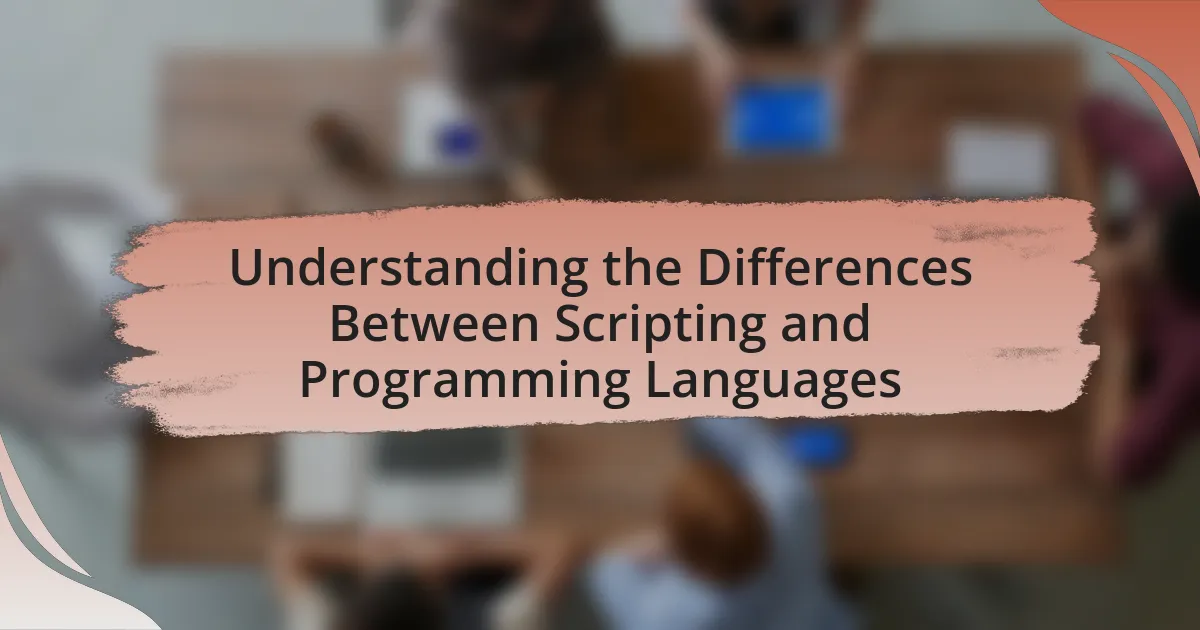The article focuses on the fundamental differences between scripting and programming languages, highlighting their distinct execution models and usage contexts. Scripting languages, such as Python and JavaScript, are typically interpreted at runtime, facilitating rapid development and automation, while programming languages like C++ and Java are compiled, offering better performance for complex applications. The article further explores the roles of interpreters and compilers, typical use cases for each type of language, and the impact of language choice on software development, scalability, and maintenance. Additionally, it addresses common misconceptions about the capabilities of scripting languages and provides insights into best practices for developers when selecting between these two categories of languages.

What are the fundamental differences between scripting and programming languages?
Scripting languages and programming languages differ primarily in their execution and usage contexts. Scripting languages, such as Python and JavaScript, are typically interpreted at runtime, allowing for rapid development and ease of use in automating tasks or enhancing web pages. In contrast, programming languages like C++ and Java are often compiled into machine code before execution, which can lead to better performance and optimization for complex applications.
Additionally, scripting languages are generally designed for specific tasks and often rely on existing frameworks or environments, while programming languages provide more extensive control over system resources and are suited for building standalone applications. This distinction is supported by the fact that scripting languages are frequently used for tasks like web development and system administration, whereas programming languages are employed in software development and systems programming.
How do scripting languages differ from programming languages in terms of execution?
Scripting languages differ from programming languages primarily in their execution model; scripting languages are typically interpreted at runtime, while programming languages are often compiled into machine code before execution. This means that scripting languages execute instructions directly from the source code, allowing for more flexibility and ease of use, particularly in automating tasks and rapid development. In contrast, programming languages usually require a compilation step, which translates the code into a binary format that the computer’s processor can execute, resulting in potentially faster performance. For example, languages like Python and JavaScript are commonly used as scripting languages, while C and C++ are examples of compiled programming languages. This distinction in execution impacts how developers approach coding, debugging, and deployment.
What is the role of interpreters in scripting languages?
Interpreters in scripting languages execute code line by line, translating high-level instructions into machine code at runtime. This allows for immediate execution and testing of scripts without the need for a separate compilation step, which is typical in traditional programming languages. For example, languages like Python and JavaScript rely on interpreters to facilitate rapid development and debugging, enabling developers to see results instantly. The use of interpreters also supports dynamic typing and flexibility, as scripts can be modified and executed on-the-fly, enhancing productivity in scripting environments.
How do compilers function in programming languages?
Compilers translate high-level programming language code into machine code, enabling the execution of programs on a computer. They perform several key functions: lexical analysis, syntax analysis, semantic analysis, optimization, and code generation. During lexical analysis, the compiler breaks the source code into tokens. Syntax analysis checks the tokens against the grammatical rules of the language. Semantic analysis ensures that the code makes logical sense. Optimization improves the efficiency of the generated code, and finally, code generation produces the machine code that the computer can execute. This process is essential for transforming human-readable code into a format that machines can understand and execute efficiently.
What are the typical use cases for scripting languages compared to programming languages?
Scripting languages are typically used for automating tasks, manipulating data, and enhancing web applications, while programming languages are used for developing standalone applications and system-level programming. Scripting languages like Python and JavaScript excel in rapid development and ease of use, making them ideal for tasks such as web development, data analysis, and system administration. In contrast, programming languages like C++ and Java are suited for performance-intensive applications, such as game development and operating systems, where efficiency and control over system resources are critical. This distinction is supported by the fact that scripting languages often interpret code at runtime, allowing for quick iterations, whereas programming languages usually compile code, resulting in optimized performance for complex applications.
In what scenarios are scripting languages preferred?
Scripting languages are preferred in scenarios that require rapid development, automation of tasks, and integration with other software systems. These languages, such as Python, JavaScript, and Ruby, enable developers to write code quickly and efficiently, often with less overhead than traditional programming languages. For instance, in web development, JavaScript is essential for creating interactive user interfaces, while Python is frequently used for automating repetitive tasks and data analysis due to its simplicity and readability. Additionally, scripting languages are ideal for prototyping and testing because they allow for immediate execution and iteration, which accelerates the development process.
What types of applications are commonly built with programming languages?
Programming languages are commonly used to build a variety of applications, including web applications, mobile applications, desktop applications, game development, and system software. Web applications, for instance, are often developed using languages like JavaScript, HTML, and CSS, while mobile applications typically utilize Swift for iOS and Kotlin for Android. Desktop applications can be created using languages such as C# or Java, and game development frequently employs C++ or C#. System software, which includes operating systems and utilities, is primarily built using low-level languages like C or assembly language. These applications demonstrate the versatility of programming languages in addressing different technological needs across various platforms.

Why is it important to understand the differences between scripting and programming languages?
Understanding the differences between scripting and programming languages is crucial for effective software development and problem-solving. Scripting languages, such as Python and JavaScript, are typically interpreted and designed for automating tasks and enhancing web functionality, while programming languages, like C++ and Java, are compiled and used for building complex applications with more control over system resources. Recognizing these distinctions allows developers to choose the appropriate language for specific tasks, optimizing performance and efficiency. For instance, a study by the IEEE Computer Society highlights that selecting the right language can significantly impact development speed and resource management, underscoring the importance of this understanding in real-world applications.
How can knowledge of these differences impact software development?
Knowledge of the differences between scripting and programming languages can significantly impact software development by influencing the choice of tools and methodologies used in projects. Understanding these distinctions allows developers to select the appropriate language for specific tasks, optimizing performance and efficiency. For instance, scripting languages like Python or JavaScript are often preferred for rapid development and automation tasks due to their ease of use and flexibility, while programming languages like Java or C++ are chosen for performance-intensive applications requiring more control over system resources. This informed decision-making can lead to reduced development time and improved software quality, as evidenced by studies showing that projects utilizing the right language for the task at hand experience up to 30% faster completion rates.
What advantages do developers gain from choosing the right language?
Developers gain significant advantages from choosing the right programming language, including improved efficiency, better performance, and enhanced maintainability of code. Selecting a language that aligns with project requirements allows developers to leverage specific features and libraries, which can accelerate development time. For instance, using Python for data analysis can reduce the amount of code needed due to its extensive libraries like Pandas and NumPy, leading to faster implementation. Additionally, languages optimized for performance, such as C++, can execute tasks more quickly than interpreted languages, thus improving application responsiveness. Furthermore, choosing a language with strong community support and documentation, like JavaScript, facilitates easier troubleshooting and collaboration, ultimately resulting in more maintainable code.
How does language choice affect project scalability and maintenance?
Language choice significantly impacts project scalability and maintenance by influencing performance, community support, and ease of integration. For instance, languages like Java and C# are statically typed and compiled, which can enhance performance and scalability in large systems, while dynamically typed languages like Python may offer faster development cycles but can lead to challenges in maintaining large codebases due to runtime errors. Furthermore, languages with robust ecosystems, such as JavaScript, provide extensive libraries and frameworks that facilitate scalability and maintenance, as they allow developers to leverage existing solutions rather than building from scratch. Studies show that projects using languages with strong community support tend to have better long-term maintenance outcomes, as they benefit from ongoing updates and shared knowledge.
What misconceptions exist about scripting and programming languages?
A common misconception about scripting and programming languages is that scripting languages are inherently less powerful than programming languages. This belief stems from the historical context where scripting languages, such as JavaScript and Python, were primarily used for automating tasks and enhancing web pages, while traditional programming languages like C++ and Java were associated with building complex applications. However, many modern scripting languages have evolved to support extensive functionalities, including object-oriented programming and large-scale application development. For instance, Python is widely used in data science, machine learning, and web development, demonstrating its capability to handle complex tasks typically associated with programming languages. This evolution illustrates that the distinction between scripting and programming languages is not about power but rather about their intended use and execution environment.
Why do some people believe scripting languages are inferior to programming languages?
Some people believe scripting languages are inferior to programming languages due to perceptions of performance and capability. Scripting languages, often interpreted at runtime, can be slower than compiled programming languages, which are optimized for performance. Additionally, critics argue that scripting languages lack the robustness and features of traditional programming languages, making them less suitable for large-scale applications. For instance, languages like C++ and Java are often favored for system-level programming because they provide more control over system resources and memory management, which is crucial for performance-intensive applications. This belief is reinforced by historical contexts where scripting languages were primarily used for automating tasks or web development, while programming languages were associated with more complex software development.
How can these misconceptions affect learning and career choices in tech?
Misconceptions about the differences between scripting and programming languages can significantly hinder learning and career choices in tech. For instance, believing that scripting languages are inferior to programming languages may discourage individuals from pursuing careers that utilize languages like Python or JavaScript, which are essential in web development and data analysis. This misconception can lead to a lack of engagement with valuable learning opportunities, as students may overlook the practical applications and job prospects associated with scripting languages. According to a survey by Stack Overflow, 69% of developers use scripting languages, indicating their relevance in the industry. Thus, misconceptions can limit both educational pathways and professional growth in technology fields.

What are the key characteristics of popular scripting and programming languages?
Popular scripting and programming languages share key characteristics that define their functionality and usability. These languages typically feature high-level syntax, which enhances readability and ease of use, allowing developers to write code more efficiently. Additionally, they often support dynamic typing, enabling variables to change types at runtime, which increases flexibility in coding.
Furthermore, popular languages like Python and JavaScript are interpreted rather than compiled, allowing for immediate execution of code without a separate compilation step, which accelerates the development process. They also provide extensive libraries and frameworks that facilitate rapid application development by offering pre-built functions and tools.
Moreover, community support and documentation are significant characteristics, as languages with strong communities, such as Ruby and PHP, tend to have abundant resources for learning and troubleshooting, which enhances their adoption and longevity in the industry.
What are some examples of widely used scripting languages?
Some examples of widely used scripting languages include JavaScript, Python, Ruby, PHP, and Perl. JavaScript is primarily used for web development to create interactive elements on websites, while Python is favored for its readability and versatility in various applications, including web development and data analysis. Ruby is known for its elegant syntax and is often used in web applications, particularly with the Ruby on Rails framework. PHP is widely used for server-side scripting in web development, and Perl is recognized for its text processing capabilities and system administration tasks. These languages are prevalent due to their ease of use and strong community support.
What features make Python a popular scripting language?
Python’s popularity as a scripting language stems from its simplicity, readability, and extensive libraries. The language’s syntax is designed to be clear and concise, allowing developers to write code quickly and efficiently. Additionally, Python boasts a vast ecosystem of libraries and frameworks, such as NumPy for numerical computations and Flask for web development, which facilitate rapid application development. According to the TIOBE Index, Python consistently ranks among the top programming languages, reflecting its widespread adoption and community support. These features collectively contribute to Python’s status as a preferred choice for scripting tasks across various domains.
How does JavaScript serve as a versatile scripting language for web development?
JavaScript serves as a versatile scripting language for web development by enabling dynamic content creation, interactivity, and asynchronous communication within web applications. Its ability to run in the browser allows developers to manipulate the Document Object Model (DOM) in real-time, enhancing user experience through responsive interfaces. Furthermore, JavaScript supports various programming paradigms, including functional and object-oriented programming, which increases its adaptability for different project requirements. The widespread adoption of JavaScript frameworks and libraries, such as React and Angular, further demonstrates its flexibility and efficiency in building complex web applications. According to the 2023 Stack Overflow Developer Survey, JavaScript remains the most commonly used programming language, highlighting its integral role in modern web development.
What are some examples of widely used programming languages?
Some examples of widely used programming languages include Python, Java, JavaScript, C++, and C#. Python is known for its readability and versatility, making it popular in data science and web development. Java is widely used in enterprise environments and Android app development. JavaScript is essential for web development, enabling interactive web pages. C++ is utilized in system/software development and game programming due to its performance efficiency. C# is primarily used in developing Windows applications and game development with Unity. These languages are recognized for their extensive community support and application in various domains.
What distinguishes Java as a robust programming language?
Java is distinguished as a robust programming language primarily due to its strong memory management, exception handling, and platform independence. The language employs automatic garbage collection, which helps manage memory efficiently and reduces memory leaks. Additionally, Java’s built-in exception handling mechanism allows developers to create more reliable applications by managing runtime errors effectively. Furthermore, Java’s “write once, run anywhere” capability, enabled by the Java Virtual Machine (JVM), ensures that Java applications can run on any device that has the JVM installed, enhancing portability and versatility. These features collectively contribute to Java’s reputation for robustness in software development.
How does C++ provide performance advantages in programming?
C++ provides performance advantages in programming primarily through its ability to compile to machine code, which allows for faster execution compared to interpreted languages. This compilation process enables C++ to optimize code at compile time, resulting in efficient memory management and reduced runtime overhead. Additionally, C++ supports low-level memory manipulation, giving programmers fine control over system resources, which can lead to performance improvements in resource-intensive applications. The language’s support for object-oriented programming and templates also allows for code reuse and optimization, further enhancing performance. These features collectively contribute to C++ being a preferred choice for high-performance applications, such as game development and systems programming.
What best practices should developers follow when choosing between scripting and programming languages?
Developers should evaluate the specific use case and performance requirements when choosing between scripting and programming languages. Scripting languages, such as Python and JavaScript, are typically easier to write and execute quickly, making them suitable for automation and rapid development. In contrast, programming languages like C++ and Java offer more control over system resources and performance, which is essential for resource-intensive applications.
Additionally, developers should consider the ecosystem and community support surrounding each language, as a strong community can provide valuable libraries and frameworks that enhance productivity. For instance, Python has a vast ecosystem for data science, while JavaScript dominates web development.
Finally, developers should assess their team’s expertise and the learning curve associated with each language, as familiarity can significantly impact development speed and project success.

Leave a Reply